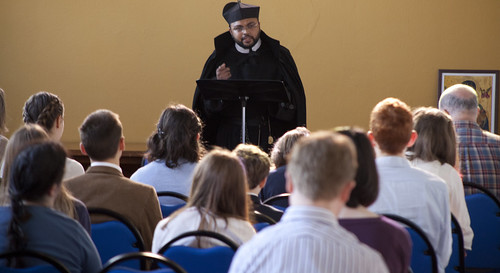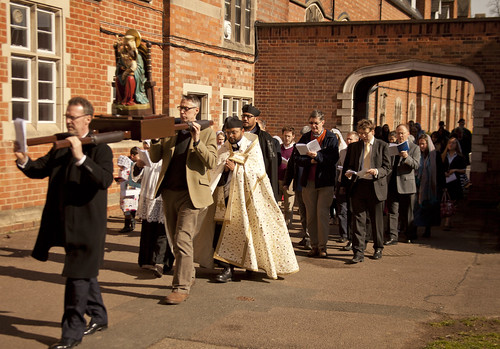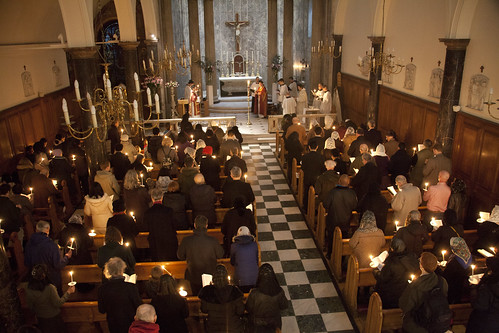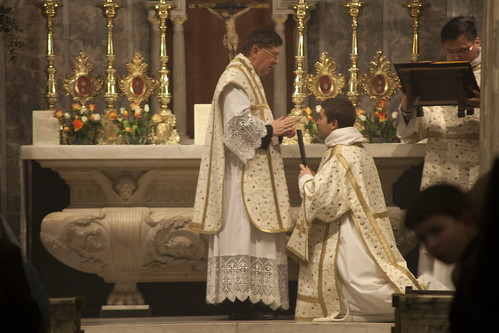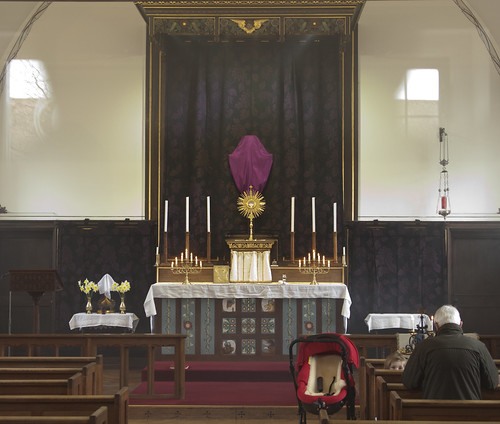Chairman's Blog
Amoris laetitia: Is it possible to keep the Natural Law?
One very puzzling thing that Amoris laetitia says is this, from Section 301.
... it is can no longer simply be said that all those in any “irregular” situation are living in a state of mortal sin and are deprived of sanctifying grace. More is involved here than mere ignorance of the rule. A subject may know full well the rule, yet have great difficulty in understanding “its inherent values”, or be in a concrete situation which does not allow him or her to act differently and decide otherwise without further sin. As the Synod Fathers put it, “factors may exist which limit the ability to make a decision”.
There is then a reference to Aquinas' Summa Theologica (and the De Malo), and to the Catechism on mitigating circumstances.
A natural reading of this, which would also seem needed by the argument which follows about what we can expect of people in regard to straightening out their lives, would be simply this: sometimes it is actually impossible to follow the objective dictates of Natural Law, and for that reason people can't be blamed for not following them: and that in this we are talking about people in a state of grace. There is also the suggestion that people may be in a dilemma (or 'perplexity') in which there is no non-sinful option.
We need to keep in mind the teaching of the Council of Trent, Chapter XI.
But no one, how much soever justified, ought to think himself exempt from the observance of the commandments; no one ought to make use of that rash saying, one prohibited by the Fathers under an anathema,-that the observance of the commandments of God is impossible for one that is justified. For God commands not impossibilities, but, by commanding, both admonishes thee to do what thou are able, and to pray for what thou art not able (to do), and aids thee that thou mayest be able; whose commandments are not heavy; whose yoke is sweet and whose burthen light. For, whoso are the sons of God, love Christ; but they who love him, keep his commandments, as Himself testifies; which, assuredly, with the divine help, they can do.
This is infallible teaching, as expressed in the following Canon:
CANON XVIII.-If any one saith, that the commandments of God are, even for one that is justified and constituted in grace, impossible to keep; let him be anathema.
The reference to Aquinas made in the footnote to this passage is not helpful. Summa Theologica IaIIae Q65 a.3 ad 2 is about impediments to the exercise of certain virtues, but far from being impediments which excuse the agent in failing to fulfill a duty, these are impediments which don't stop the agent from acting on the virtue. It is a reference to Aristotle's theory that the excercise of a habit (good, bad, or mechanical) gives pleasure unless the exercise is 'impeded'; Aquinas is simply pointing out that impediments are more likely when the virtue has not been acquired by a process of training and habituation over time, but by an infusion of grace from God. This abstruse issue is completely irrelevant to the matter at hand, and makes me wonder about the intellectual integrity of the people advising Pope Francis at this point in the document.
Reference to the Catechism's considerations about mitigating factors such as duress, inadvertance, habit and so forth is also potentially misleading. Mitigating factors are mitigating: they don't change a bad action into a good one, but reduce the degree of guilt we bear for an objectively wrong action. Does this include making an action which could be a mortal sin into a non-mortal sin? Well, in mortal sin the agent must be conscious of the gravity of the act, and various factors can indeed obscure this for an agent. The odd thing about this paragraph, however, is that it does not want to focus on factors which affect the agent's knowledge of an action's gravity: 'More is involved here than mere ignorance of the rule.' What are we supposed to make of that? It is precisely ignorance of the rule, or the way it applies in a particular case, which is key in claiming that an objectively gravely wrong action is not a mortal sin, and that therefore the agent has not necessarily lost the state of grace.
It is hard to avoid the impression that this paragraph is trying to create a casuistic space for the idea that someone who is living a life of - for example - institutionalised adultery, in an illict marriage, who is perfectly aware of the teaching of the Church and equally aware that he and his supposed spouse are not free to marry each other, could be in a state of grace, and therefore could appropriately and fruitfully receive Holy Communion.
But that view is false. If you know that what you are doing is gravely sinful, and keep on doing it, you have committed a mortal sin and are not in a state of grace. Habits, duress, the needs of the children of the supposed marriage and all sorts of things can make it psychologically difficult to undergo the necessary conversion of heart: certainly. But God's mercy is available even for such sinners. Not the false mercy of leaving in their sin, but the mercy of granting them the grace of repentance and forgiveness.
Compare the parents of a family whose prosperity is founded upon some kind of grave injustice: a mafia family, say, whose money comes from extortion, kidnapping, and other crimes. All kinds of habits and duress will make repentance difficult. The obligation to support one's children creates a dilemma, also, for the parents, whose livlihood depends on grave sins. But none of this means that repentance is impossible, and while it would be a sin to plunge one's family into danger and poverty by intention or by negligance, it is not a sin to cause this result as a side-effect of leaving a gravely sinful lifestyle. In this case the subsequent danger and poverty are attributable, in fact, to earlier sins of the parents catching up with them. In other cases, even this may not be true: Blessed Franz Jägerstätter, an Austrian Catholic who refused to fight for the Nazis in 1943, left his young family in a vulnerable state when he went to his heroic death, but that was not wrong, because he was doing his duty.
Amoris laetitia does not make any definitive rules for or any changes to Canon Law; nor does it explictly contradict or re-write the Catechism, Pope St John Paul II's Familiaris consortio, or any other document which states the teaching of the Church: that public sinners should be refused Communion, and that those in a state of mortal sin cannot receive Communion fruifully. Instead it invites, more forcefully and authoritatively than before, that we should all treat individual cases on their merits. And so we should. It would be unfortunate if we did so on the basis of confusion about what mortal sin is.
Support the work of the LMS by becoming an 'Anniversary Supporter'.
Pope Francis on Fatherhood and authority
 |
| Children in Mass at the recent Family Retreat, |
Since the Post-Synodal Exhortation Amoris laetitia is not the bombshell many were assuming, confining itself, on the 'hot button' issues, to what appears to be a restatment of the status quo (priests have to assess matters case by case, Holy Communion is not a reward for perfection etc. etc.), here is something which other news sources may neglect, but which was mentioned briefly in the Press Conference: the Holy Father has a surprising amount to say about Fathers. Surprising only because it is a subject, as I have lamented on this blog, which has been somewhat neglected in the Church. So here is a long quotation, sections 175-177. (Mothers are discussed in the immediately preceding sections. I don't include the footnotes, which refer to the sources of the internal quotations: mostly speeches of Pope Francis himself.) The full text is here (h-t Edward Pentin).
A mother who watches over her child with tenderness and compassion helps him or her to grow in confidence and to experience that the world is a good and welcoming place. This helps the child to grow in self-esteem and, in turn, to develop a capacity for intimacy and empathy. A father, for his part, helps the child to perceive the limits of life, to be open to the challenges of the wider world, and to see the need for hard work and strenuous effort. A father possessed of a clear and serene masculine identity who demonstrates affection and concern for his wife is just as necessary as a caring mother. There can be a certain flexibility of roles and responsibilities, depending on the concrete cirumstances of each particular family. But the clear and well-defined presence of both figures, female and male, creates the environment best suited to the growth of the child.
We often hear that ours is “a society without fathers”. In Western culture, the father figure is said to be symbolically absent, missing or vanished. Manhood itself seems to be called into question. The result has been an understandable confusion. “At first, this was perceived as a liberation: liberation from the father as master, from the father as the representative of a law imposed from without, from the father as the arbiter of his children’s happiness and an obstacle to the emancipation and autonomy of young people. In some homes authoritarianism once reigned and, at times, even oppression”. Yet, “as often happens, one goes from one extreme to the other. In our day, the problem no longer seems to be the overbearing presence of the father so much as his absence, his not being there. Fathers are often so caught up in themselves and their work, and at times in their own self-fulfilment, that they neglect their families. They leave the little ones and the young to themselves”. The presence of the father, and hence his authority, is also impacted by the amount of time given over to the communications and entertainment media. Nowadays authority is often considered suspect and adults treated with impertinence. They themselves become uncertain and so fail to offer sure and solid guidance to their children.
A reversal of the roles of parents and children is unhealthy, since it hinders the proper process of development that children need to experience, and it denies them the love and guidance needed to mature.
God sets the father in the family so that by the gifts of his masculinity he can be “close to his wife and share everything, joy and sorrow, hope and hardship. And to be close to his children as they grow – when they play and when they work, when they are carefree and when they are distressed, when they are talkative and when they are silent, when they are daring and when they are afraid, when they stray and when they get back on the right path. To be a father who is always present. When I say ‘present’, I do not mean ‘controlling’. Fathers who are too controlling overshadow their children, they don’t let them develop”. Some fathers feel they are useless or unnecessary, but the fact is that “children need to find a father waiting for them when they return home with their prob-lems. They may try hard not to admit it, not to show it, but they need it”. It is not good for children to lack a father and to grow up before they are ready,
Support the work of the LMS by becoming an 'Anniversary Supporter'.
New Catholic School in Bedfordshire
Support the work of the LMS by becoming an 'Anniversary Supporter'.
Photos from the Family Retreat
Support the work of the LMS by becoming an 'Anniversary Supporter'.
Is Mass in the vernacular inaudible?
In the Catholic Herald of 18th March, Ann Widdecombe suggested that it frequently is: so much so, that with the withdrawal by her parish priest of sheets with the proper prayers and readings printed on them, she has resorted to using a hand missal, as have many others in her parish.
There have been a lot of complaints from liberals about the unintelligibility of the vocabulary of the 2011 English translation, which contains hard words like 'ineffable', 'venerable' and 'contrite', but Widdecombe's difficulty is a separate issue entirely. She wants a printed text to look at because she can't understand badly read or heavily accented lections, mumbled psalms, or words overlaid with the crying of babies. (Her article is not on the Catholic Herald website, but on the right is the money quote.)
We can all sympathise with Widdecombe's problem, but her solution suggests something very strange and very un-liturgical: a group of people simultaneously reading a liturgical text is no-one idea of a common act of worship. The problem has arisen because, odd as it may seem, putting the liturgy into the vernacular has not made it accessible to the congregation, even when it is the congregation's own vernacular. If people feel the need to follow the text in a printed form, then they might as well be hearing the Mass in Latin.
Widdecombe is right: it is quite difficult hearing and understanding a text being read out. I had a formative experience as a graduate student attending a small academic conference, where the speakers used the complete range of approaches to giving their talks: from the word-by-word reading of a text, at one extreme, to the complete ex tempore experience. It became very clear that, in reading a text, the modulations of the voice, so important to make spoken English readily intelligible, tend to be flattened out. This is less so if the text is very familiar, or even learnt off by heart, but this still doesn't come out in a conversational way. A carefully prepared, but note-free talk from the energetic American ethical theorist Brad Hooker was positivly electrifying, by comparison with many other presentations. The trick was that he knew exactly what he wanted to say, but hadn't selected the words and phrases in advance: he was just telling us his ideas, as he might have done in the course of an animated conversation.
 |
| Douglas Adams' permanently depressed robot, Marvin. |
Such an approach is of course impossible for readers in church, and as different from a liturgical experience as can be imagined. This contrast, however, between how readily we can grasp the meaning of ex tempore speech, and the more solemn proclamation of venerable liturgical texts, has not been sufficiently taken into account in the debate about 'having the Mass in English'. A lay reader at Mass, with little or no training, who may never have seen the text before and may have difficulty understanding it at first glance (no shame there, of course), straining to avoid the smallest error in reading it out, is predictably going to sound as enthralling as Marvin the Paranoid Android. Give the poor lector an unfamiliar accent and a little stage-fright and, yes, the congregation will be reaching for their little sheets or missals.
What if the reader is highly trained, and manages to inject the text with suitable solemnity? This is likely to obscure the meaning in a somewhat different way. Again, conversational modulations of the voice will be flattened out, this time on purpose: you don't actaully want the Epistle to sound like a racy story told in the pub. Before we get too excited, like Ann Widdecombe, about how well the Anglicans do it - or once did - bear in mind that they had two huge advantages: a semi-professional cadre of lectors (the Parish Clerk et al.: no chance of it being a form of liturgical participation for the ordinary pew-sitter), and the ancient, one-year Lectionary, (almost) identical in the Book of Common Prayer and the 1962 Roman Missal. The familiarity of the readings makes it possible to undertand them even if they are read in a somewhat stylised way. Or, for that matter, in Latin...
So, remind me again, what exactly was the point of having the Liturgy of the Word in the vernacular?
The advantages of Latin are many. First, it makes possible the use of the ancient tradition of chanting the text, which is a major aspect of the Latin Church's musical patrimony, one which has been unjustly taken away from most Catholics. Again, whether sung or said, a Latin text is equally possible for people of any language to follow: if they want translations into their preferred language, whether Polish or Irish, they can have them. If they are going to equip themselves, like Ann Widdecombe, with a hand missal, for major languages they can even choose their own translation in the Extraordinary Form, since unlike with the Novus Ordo a hand-missal is just an aid to devotion, not an official liturgical book tied to whatever version of the vernacular lectionary the local bishops have adopted.
Yes, hand missals for the EF can be revised and updated without the agreement of the entire English-speaking (or Francophone, or German, or whatever) world. As a matter of fact, the effort to approve a new version of the English Lectionary was abandoned in 2014, becuase of the difficulty of getting everyone to agree about it. OF Mass-goers are going to be listening to the long-superceded, 1966 'Jerusalem Bible' version, justly derided for being a translation not from the ancient languages but from French, for many years to come.
But above all, the use of Latin for the lections serves to make the point that the whole of Mass is an offering to God: as Vatican II said, the whole of Mass is a single act of worship (Sacrosanctum Concilium 51). It is misleading to imagine the Liturgy of the Word as didactic (teaching) rather than latreutic (worshipping): all parts of the Mass contain texts edifying to the Faithful, but all are in the service of God, in praise and thanksgiving. It is part of a sacred time, and the use of a sacred language is appropriate. Perhaps if this reality was more vividly presented to Ann Widdecombe's fellow parishioners, they wouldn't be quite as keen to keep their noses in a book while the Holy Sacrifice is taking place just a few feet away from them in the Sanctuary.

But then, with more than a dozen Eucharistic Prayers to choose from, is there any part of the Ordinary Form Mass with which they could even gain the kind of easy familiarity regular worshippers at the Extraordinary Form take for granted? It must be conceded, contrary to Widdecombe, that the whole construction of the OF assumes that the Faithful will be able to understand everything instantly as they hear it, and indeed seems premised on the assumption that this not only makes possible the use of a wider range of texts, but that this choice is a useful antidote to boredom.
On the last point, they may have over-estimated the degree of excitement yet another 1960s-era liturgical text or Scriptural translation is capable of eliciting.
See the Position Paper on the Proclamation of the Lections in Latin in the Extraordinary Form.
Support the work of the LMS by becoming an 'Anniversary Supporter'.
Photos of the Easter Vigil at St Mary Moorfields
I was present myself at this and these are my photos. There was a terrific rainstorm halfway through the service, but we managed to get through the Holy Fire part of the service with just a little drizzle.
St Mary Moorfields was packed, which means upwards of 200 people were present.
A big 'thank you' is needed for the clergy, under Fr Michael Cullinan, servers and singers for all the very demanding services of the Easter Triduum: three sets of Tenebrae and the three major services of Holy Thursday, Good Friday, and the Easter Vigil on the Saturday. For these Richard Picket was an expert MC. Matthew Schellhorn with his Cantusy Magnus provided wonderful music for all of them. Our most ambitious set of Triduum services to date was also the most successful and the best attended.
Support the work of the LMS by becoming an 'Anniversary Supporter'.
Photos of Good Friday at St Mary Moorfields
The full set of Good Friday photos here.
It was organised by the Latin Mass Society and celebrated by Fr Michael Cullinan.
Support the work of the LMS by becoming an 'Anniversary Supporter'.
Public Masses at Prior Park during the Priest Training Conference
The chapel at Prior Park is stunning; anyone in the area should take the opportunity of the LMS Priest Training Conference to attend of the public Masses taking place there next week.
Monday 4th April: 5.00pm Solemn Mass of the AnnunciationTuesday 5th April: 11.00am Mass of Vincent FerrerWednesday 6th April: 11.00am Solemn Requiem MassThursday 7th April: 11.00am Solemn Votive Mass of OLJC In addition to these, there will be Vespers and Benediction on Tuesday 5th at 5.00pmSupport the work of the LMS by becoming an 'Anniversary Supporter'.
Recent Photos
Benediction in Passiontide in SS Gregory & Augustine's, Oxford.
Tenebrae in St Mary Moorfields, on Spy Wednesday. 
Support the work of the LMS by becoming an 'Anniversary Supporter'.
Surrexit! He is risen.
 From the Rosary Walk at Aylesford Priory.
From the Rosary Walk at Aylesford Priory.
Happy Easter!
Support the work of the LMS by becoming an 'Anniversary Supporter'.


